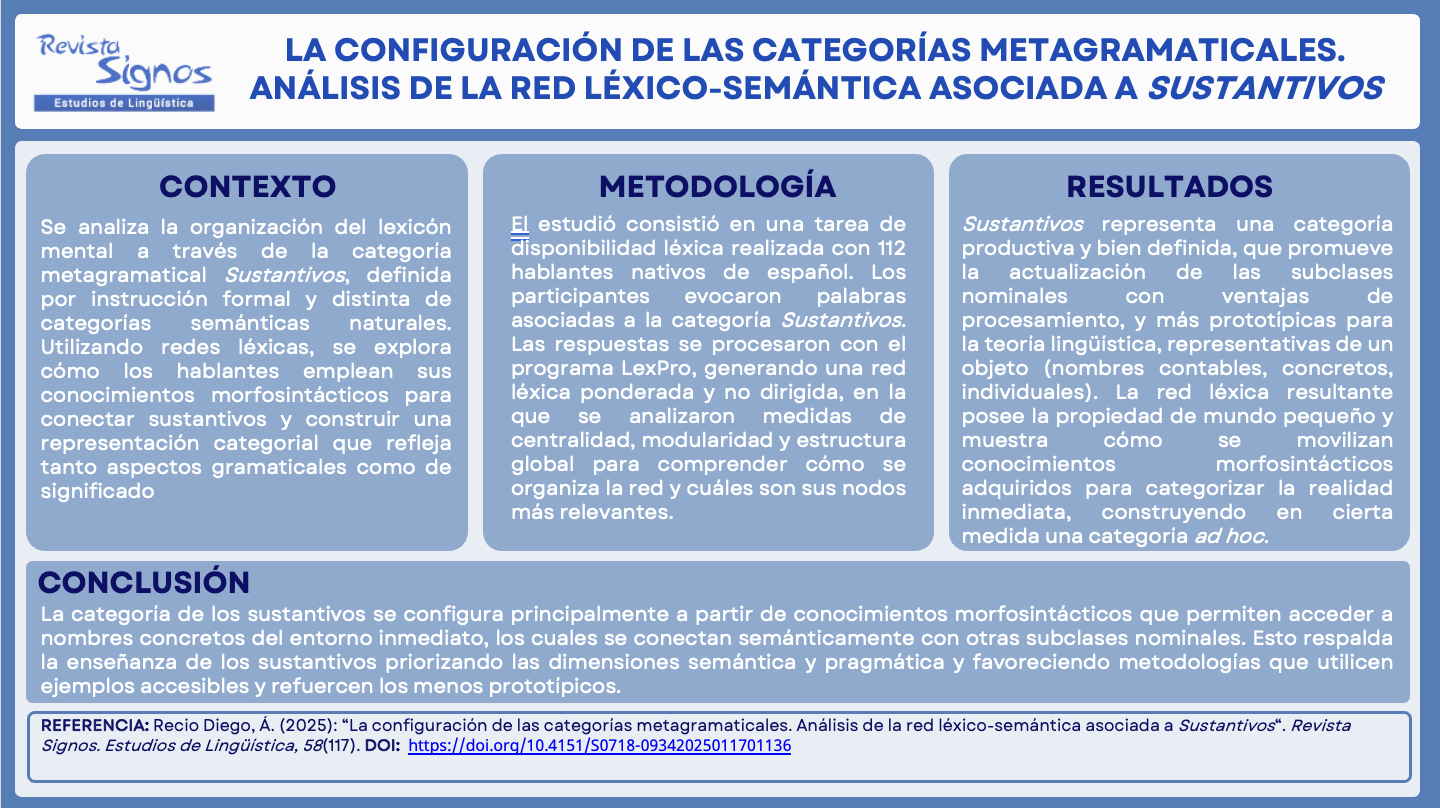La configuración de las categorías metagramaticales
Análisis de la red léxico-semántica asociada a Sustantivos
DOI:
https://doi.org/10.4151/S0718-09342025011701136Palabras clave:
disponibilidad léxica, fluencia semántica, redes léxicas, grafos, lexicón mentalResumen
Como ventana a la organización del lexicón mental, este trabajo propone el análisis de la producción léxica y de la estructura interna de una categoría metagramatical: Sustantivos. A partir de las respuestas de 112 hablantes nativos de español en una prueba de disponibilidad léxica, se lleva a cabo una caracterización semántico-gramatical de los nombres más disponibles y se construye un grafo no ponderado y no dirigido, desde el enfoque de la teoría de las redes complejas, para analizar su estructura. De acuerdo con nuestros resultados, Sustantivos representa una categoría productiva y perfectamente definida, que promueve la actualización de las subclases nominales que han mostrado ventajas de procesamiento en otros ámbitos y tareas, y que más prototípicas resultan para la teoría lingüística, representativas de un objeto (nombres contables, concretos, individuales). La red léxica resultante posee la propiedad de mundo pequeño y muestra cómo los informantes movilizan los conocimientos morfosintácticos adquiridos para categorizar la realidad inmediata, construyendo en cierta medida una categoría ad hoc en la que los nodos que designan objetos del entorno próximo ocupan una posición nuclear.
Citas
Agustín Llach, M. P., & Palapanidi, K. (2021). On lexical uniqueness and lexicon organization in native Spanish and Greek SFL learners. Onomázein: Revista de Lingüística, Filología, 54, 142-178.
Aitchison, J. (2003). Words in the mind: An introduction to the mental lexicon. Wiley-Blackwell.
Alonso, M. A., Fernández, A., & Díez, E. (2015). Subjective age-of-acquisition norms for 7,039 Spanish words. Behav Res, 47, 268-274.
Ávila Muñoz, A. M. (2023). Avance de una propuesta para el desarrollo de la tradición lexicoestadística hispánica: el índice de centralidad léxica. Nueva Revista de Filología Hispánica, 71(1), 3-29.
Barsalou, L. W. (1991). Deriving categories to achieve goals. En G. H. Bower (Ed.), The Psychology of Learning and Motivation: Advances in Research and Theory (pp. 1-64). Academic Press.
Barsalou, L. W. (2010). Ad hoc categories. En P. C. Hogan (Ed.), The Cambridge encyclopedia of the language sciences (pp. 86-87). Cambridge University Press.
Bartol, J. A. (2001). Reflexiones sobre la disponibilidad léxica. En J. A. Bartol, C. Fernández Juncal, S. Crespo, C. Pensado, E. Prieto & M. Sánchez (Eds.), Nuevas aportaciones al estudio de la lengua española. Investigaciones filológicas (pp. 221-236). Luso-Española Ediciones.
Borodkin, K., Kenett, Y. N., Faust, M., & Mashal, N. (2016). When pumpkin is closer to onion than to squash: The structure of the second language lexicon. Cognition, 156, 60-70.
Callealta, F. J., & Gallego D. J. (2016). Medidas de disponibilidad léxica: comparabilidad y normalización. Boletín de Filología, 51(1), 39-92.
Camarena Ortiz, E. D. (2010). La interlengua en el léxico disponible de un grupo alumnos de portugués en México. En I. Moskowich, B. Crespo, I. Lareo & P. Lojo (Eds.), Language Windowing through Corpora. Visualización del lenguaje a través de corpus, Vol. I (pp. 145-155). U. La Coruña.
Camps, A. (2014). Hacia una renovación de la enseñanza de la gramática. Lenguaje y Textos, 40, 7-18.
Caramazza, A., & J. R. Shelton (1998). Domain-specific knowledge systems in the brain: the animate-inanimate distinction. Journal of Cognitive Neuroscience, 10, 1-34.
Clauset, A., Newman, M. E. J. & Moore, C. (2004). Finding community structure in very large networks. Physical review. E, Statistical, nonlinear, and soft matter physics, 70(6). https://doi.org/10.48550/arXiv.cond-mat/0408187.
Cruz Alonso, R. (2016): El léxico disponible de Castilla y León. Ediciones Universidad de Salamanca.
Durán, C. (2009). Hablar, escuchar y pensar para aprender gramática. Cuadernos de Pedagogía, 391, 67-71.
Echeverría, M., Vargas, R., Urzúa, P., & Ferreira, R. (2008). DispoGrafo: una nueva herramienta computacional para el análisis de relaciones semánticas en el léxico disponible. Revista de Lingüística Teórica y Aplicada, 46(1), 81-91.
Feng, X., & Liu, J. (2021). The structure of L2 lexical-semantic networks as seen from a social network perspective. International Review of Applied Linguistics in Language Teaching, 000010151520200181. https://doi.org/10.1515/iral-2020-0181.
Fernández, G. (2023). La disponibilidad gramatical en español: estudio en población infantil [Trabajo final de grado, Universidad de Salamanca].
Fernández Juncal, C. (2020). Entre crematónimos y topónimos: los nombres de comercios. Boletín de Filología, 55(2), 345-367. https://doi:10.4067/S0718-93032020000200345
Fernández Juncal, C. (2021a). Estructura formal del repertorio antroponímico español. Revista de filología española, 101(1), 127-149. https://doi: 10.3989/rfe.2021.005
Fernández Juncal, C. (2021b). Los nombres de marca: disponibilidad léxica y caracterización. Revista de Filología Hispánica, 37(1), 223-246. https://doi:10.15581/008.37.1.223-46
Fernández Juncal, C., & Hernández Muñoz, N. (2019). Disponibilidad léxica y socionomástica. Ogigia: Revista electrónica de estudios hispánicos, 25, 185-210. https://doi: 10.24197/ogigia.25.2019.185-210
Fitzpatrick, T., & Thwaites, P. (2020). Word association research and the l2 lexicon. Language Teaching, 53, 237-274.
García Folgado, M. J., & Rodríguez Gonzalo, C. (2015). Aportaciones a la investigación sobre la enseñanza de la gramática. Tejuelo: Didáctica de la Lengua y la Literatura. Educación, 22, 4-8.
Goikoetxea, E. (2000). Frecuencia de producción de las respuestas a 52 categorías verbales en niños de primaria. Psicológica, 21, 61-89.
Goñi, J., Arrondo, G., Sepulcre, J., Martincorena, I., Vélez de Mendizábal, N., Corominas-Murtra, B., Bejarano, B., Ardanza-Trevijano, S., Peraita, H., Wall, D. P., & Villoslada, P. (2011). The semantic organization of the animal category: evidence from semantic verbal fluency and network theory. Cogn Process, 12(2), 183-96.
Guerra Salas, L., Gómez Sánchez, M. E., & Basterrechea Salido, M. (2015). Cuantificación y representación de las asociaciones léxicas en las listas de disponibilidad: el índice de contigüidad de los vocablos. LEA: Lingüística Española Actual, 37(2), 265-277.
Hernández Muñoz, N. (2004). El léxico disponible de los estudiantes conquenses. Ediciones Universidad de Salamanca.
Humphries, M. D., & Gurney, K. (2008). Network Small-World-Ness: A Quantitative Method for Determining Canonical Network Equivalence. PLos ONE, 3(4).
Kenett, Y. N., Kenett, D. Y., Ben-Jacob, E., & Faust, M. (2011). Global and local features of semantic networks: Evidence from the Hebrew mental lexicon. PLoS ONE, 6(8), e23912. http://dx.doi.org/10.1371/journal.pone.0023912.
Kenett, Y. N., Wechsler-Kashi, D., Kenett, D. Y., Schwartz, R. G., Ben Jacob, E., & Faust, M. (2013). Semantic organization in children with cochlear implants: Computational analysis of verbal fluency. Frontiers in Psychology, 4.
López Chávez, J. (1994). Comportamiento sintáctico de algunos verbos ordenados según su grado de disponibilidad léxica. REALE, 1, 67-85.
Manjón-Cabeza Cruz, A. (2008). Redes semánticas naturales en escolares de 5 a 16 años: los colores. Docencia e investigación, 33, 149-177.
Manjón-Cabeza Cruz, A. (2010). Aproximación a la organización semántica del léxico sobre juegos y diversiones. ELUA: Estudios de Lingüística, 24, 199-224.
McDonough, C., Song, L., Hirsh-Pasek, K., Golinkoff, R. M., & Lannon, R. (2011). An image is worth a thousand words: why nouns tend to dominate verbs in early word learning. Developmental Science, 14(2), 181-189.
Moreno, M. (2022). La disponibilidad gramatical. Cotejo de datos desde el estudio piloto a las primeras fases [Trabajo final de grado, Universidad de Salamanca].
Moss, H. E., Tayler, K. L., & Taylor, K. I. (2007). Conceptual structure. En M. G. Gaskell (Ed.), The Oxford handbook of Psycholinguistics (pp- 217-250). Oxford University Press.
Newman, M. E. J. (2011). Networks: an introduction. Oxford University Press.
Paredes García, F. (2022). La categorización del adjetivo. Aportes desde la disponibilidad léxica de Madrid. Tejuelo: Didáctica de la Lengua y la Literatura. Educación, 35, 73-104.
Piñeiro, A., Morenza, L., Torres, R., & Sierra, C. E. (1999). Estudio de veinte categorías semánticas en niños y adultos. Revista de Psicología General y Aplicada, 52(1), 147-157.
Rodríguez Gonzalo, C. (2012). La enseñanza de la gramática: las relaciones entre la reflexión y el uso lingüístico. Revista Iberoamericana de Educación, 59, 87-118.
Rosch, E., Mervis, C. B., Gray, W., Johnson, D. M., & Boyes-Braen, P. (1976). Basic objects in natural categories. Cognitive Psychology, 8, 382-436.
Silles, J. (2022). Disponibilidad gramatical de los verbos en español a partir de un experimento ora. Observaciones teóricas, metodológicas y sintácticas [Trabajo fin de grado.Salamanca, Universidad de Salamanca].
Steyvers, M., & Tenenbaum, J. B. (2005). The large-scale structure of semantic networks: Statistical analyses and a model of semantic growth. Cognitive Science, 29(1), 41-78.
Tomé Cornejo, C. (2015). Léxico disponible. Procesamiento y aplicación a la enseñanza de ELE [Tesis doctoral, Universidad de Salamanca].
Tomé Cornejo, C. (2023). On experimental lexical production in Spanish as L1 and L2.: The influence of test modality and response time. Revista de Lingüística y Lenguas Aplicadas, 18, 131-144.
Tomé Cornejo, C. & Recio Diego, Á. (2022). De la disponibilidad léxica a la disponibilidad grammatical. Tejuelo, 35(3), 299-336.
Troyer, A. K. (2000). Normative data for clustering and switching on verbal fluency tasks. Journal of Clinical and Experimental Neuropsychology, 22, 370-378.
Troyer, A. K., Moscovitch, M., & Wincour, G. (1997). Clustering and switching as two components of verbal fluency: evidence from younger and older healthy adults. Neuropsychology, 11, 138-146.
Tyler, L. K., Moss, H. E., Galpin, A., & Voice, J. K. (2002). Activating meaning in time: The role of imageability and form-class. Language and Cognitive Processes, 17, 471-502.
Valenzuela, M., Pérez, M., Bustos, C., & Salcedo, P. (2018). Cambios en el concepto aprendizaje de estudiantes de pedagogía: análisis de disponibilidad léxica y grafos. Estudios Filológicos, 61, 143-173.
Vigliocco, G., & Vinson, D. P. (2007). Semantic representation. En M. G. Gaskell (Ed.), The Oxford handbook of Psycholinguistics (pp. 195-215). Oxford University Press.
Warrington, E. K., & Shallice (1984). Category-specific semantic impairments. Brain, 107, 829-854.

Publicado
Cómo citar
Número
Sección
Licencia
Derechos de autor 2025 Revista Signos. Estudios de Lingüística

Esta obra está bajo una licencia internacional Creative Commons Atribución 4.0.
Aquellos autores que tengan publicaciones con esta revista, aceptan los términos siguientes:
- Los autores conservarán sus derechos de autor y garantizarán a la revista el derecho de primera publicación de su obra por medio de este documento de cesión de derechos de autoría, el cuál estará simultáneamente sujeto a la licencia de reconocimiento de Creative Commons que permite a terceros compartir la obra siempre que se indique su autor y su primera publicación esta revista.
- Los autores podrán adoptar otros acuerdos de licencia no exclusiva de distribución de la versión de la obra publicada (p. ej.: depositarla en un repositorio institucional o publicarla en un volumen monográfico) siempre que se indique la publicación inicial en esta revista.
- Se permite y recomienda a los autores difundir su obra a través de Internet (p. ej.: en publicaciones institucionales o en su página web) antes y durante el proceso de envío, lo cual puede producir intercambios interesantes y aumentar las citas de la obra publicada. (Véase el efecto del acceso abierto).










